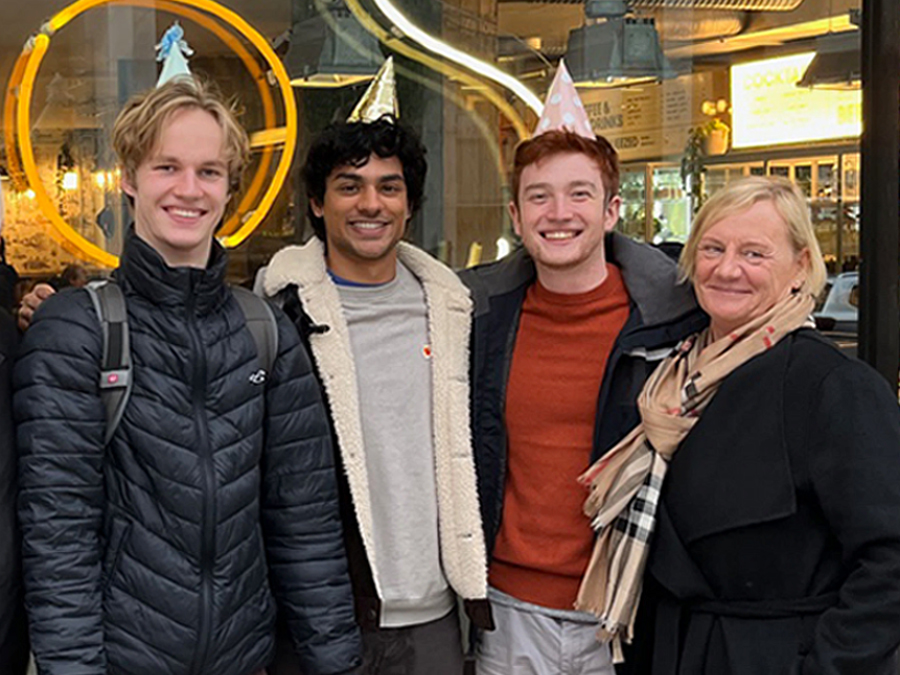
School: Carleton College, Class of ’24
Major or concentration: Economics
Semester abroad: Fall ’22
Change can be scary, and as I sat through my leg-numbingly long flight across the Atlantic, I can’t say I wasn’t a little nervous. I was excited, of course, but I knew spending a semester abroad would be a pretty big step out of my comfort zone. As a Minnesotan who wound up in Minnesota for college, being somewhere else as something other than a tourist was new for me.
In my experience, however, things weren’t nearly as stressful as I imagined–over the fifteen weeks I spent here in the cold, not-so-gloomy, incredibly cozy north, I never felt too far from home.
Part of this, I’m sure, is because of the phone in my (and everyone else’s) pocket. No one, even back home in the US, is more than a phone call away (as long as I remember what time zone I’m in). This digital connection–paired with Sweden’s enviably competent language education system–makes the country extremely accessible. Cultural immersion is easier when every cashier, waiter, and classmate speaks the same language and uses the same social media platforms as I do.
Maybe coming from Minnesota gave me some preparation. Perhaps the bitter cold of the Twin Cities in winter steeled me for the surprise of living in a Nordic country. Or, maybe the veritable smörgasbord of Swedish descendants roaming around the Land of 10,000 Lakes gave me a sneak peek into what living in Sweden would be like.
But chalking my comfort here up to technology, the Swedish education system, or my Minnesotan upbringing doesn’t really give the full picture of why Sweden felt so welcoming. These things may have made it easier to get by as an American, but I still took something uniquely Swedish away from my time here. I think the real reason Sweden fit me like a glove (or like the mittens I had to buy before our trip to the Arctic) is because Swedes take the process of bringing people together pretty seriously. Take the fika, for example.
Oh, the fika. You can’t step foot into Sweden without hearing about it. Every coffee shop is perfectly set up for a quick hangout, and none would be so remiss as to forget the kanelbulle. Building community over a shared meal is very Swedish, and I think Swedes’ hands-on and genuine approach to connection is summed up perfectly by the practice.
If a fika didn’t give enough opportunity for bonding, fear not. At the end of a long week, the Fredagsmys, or “Cozy Friday,” has you covered. It’s a tradition marked by spending the night in, with friends, family, and Tex-Mex tacos. Obviously. Swedes understand the importance of taking a deep breath and a step back, and nothing makes a break better than breaking bread.
Coming to Sweden, culture shock wasn’t the only thing on my mind. As the only student coming from my school in the US, I was preoccupied by the prospect of reliving freshman year and starting friendships over from scratch. As a perpetually hungry 20 year old, I was also worried about cooking three meals for myself every day.
It turns out, like everything else, Sweden solved these problems for me the same way they solved the rest. Getting to know Swedes and my American classmates over crawfish in August, in line for a Max hamburger, during a lunch break at SSE, or over dinner in my apartment made my study abroad experience much richer–and way easier–than I could have hoped for.
Stepping into my shiny new kitchen on day one, I wanted to make the most of the generous supply of pots and pans provided. The first time I had the new friends I worried so much about making over to my apartment, it was clear a good (or even mediocre) meal was the perfect opportunity to connect, talk, and get to know one another better. Cooking for myself was no longer a chore, and from that point on, I was hooked. Nothing made me feel more at home, or more connected, than making a meal in my apartment. And whether it was two—or twelve–people, I never could shake the feeling that I had stumbled upon the most important lesson of my studies abroad (sorry professors)–eating together is a social Swiss Army Knife. It fosters community, connection, and a sense of belonging. The Swedes are on to something.
The dinners, events, and holidays the Swedish Program hosted and celebrated with us invariably underscored this fact. There are few better ways to bring a group of hungry post-adolescents together than with a buffet or over a slice of Swedish birthday cake. When we cook together, eat together (and maybe drink öl together), it’s pretty hard not to come together.
At the end of the day, I think I never felt too far from home in Sweden because living here felt like home. Home may be where the heart is, but I think it is also where the heart-shaped pepparkakor are. And maybe those are the same thing.